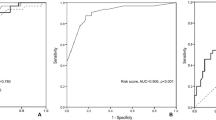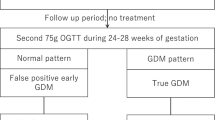Abstract
Background
Studies reported that fulminant type 1 diabetes (fT1DM) can occurred during pregnancy or within 2 weeks after delivery, and was defined as pregnancy-associated fulminant type 1 diabetes (PF). In PF patients, plasma glucose (PG) levels have an abrupt rise while glycated hemoglobin (HbA1C) levels are not markedly elevated, resulting in a sharply increased PG/HbA1C ratio.
Methods
We studied 30 PF patients, 21 non-pregnant fulminant type 1 diabetes (NPF) patients, and 26 female patients of child-bearing age (13–49 years) with diabetic ketoacidosis (DKA), all from China. We analyzed the PG/HbA1C ratio among these groups, with the goal of finding a method for predicting PF. The clinical and biochemical characteristics of the PF and NPF patients were analyzed and compared with the characteristics of the DKA patients. In order to detect PF in DKA patients, receiver-operating characteristic curves analysis was used to identify the cut-off points of the PG/HbA1C ratio.
Results
When we compared the clinical characteristics of these three groups, we found that the onset of hyperglycemic symptoms, arterial PH value, serum potassium, PG, HbA1C, fasting and postprandial serum C-peptide concentration, glutamic acid decarboxylase (GAD) antibodies positivity were all significantly different (P < 0.001). The PG/HbA1C ratio was significantly higher in PF and NPF patients (5.29 ± 1.39 and 6.38 ± 2.62) than in DKA patients (1.93 ± 0.55; P < 0.001). Receiver-operating characteristic (ROC) curves analyses showed that PG/HbA1C ratio at a cut-off value of 3.3 resulted in the highest Youden index, with corresponding sensitivity of 93 and 100% specificity for identifying PF from DKA.
Conclusions
PF patients showed a more severe acidosis, with maternal and fetal mortality rates being high. PG/HbA1C ratio with a threshold of ≥3.3 can be used as a cut-off point in predicting PF from DKA in China. Elevated PG/HbA1C ratio at the time of diagnosis is predictive for more severe insulin secretion dysfunction and poor prognosis.




Similar content being viewed by others
References
A. Imagawa, T. Hanafusa, J. Miyagawa, Y. Matsuzawa, A novel subtype of type 1 diabetes mellitus characterized by a rapid onset and an absence of diabetes-related antibodies. Osaka IDDM Study Group. N. Engl. J. Med. 342(5), 301–307 (2000)
J. Fu, B.Y. Shi, Fulminant type 1 diabetes: a distinct subtype of type 1 diabetes mellitus. J. Formos. Med. Assoc. 112(6), 363–364 (2013)
L. Liu, J. Mao, Z. Lu, X. Yan, Y. Ye, F. Jiang, Clinical analysis of fulminant type 1 diabetes in China and comparison with a nationwide survey in Japan. Ann. Endocrinol. 74(1), 36–39 (2013)
L. Liu, L. Zeng, D. Sang, Z. Lu, J. Shen, Recent findings on fulminant type 1 diabetes. Diabetes Metab. Res. Rev. 34, e2928 (2018)
A. Imagawa, T. Hanafusa, Y. Uchigata, A. Kanatsuka, E. Kawasaki, T. Kobayashi, A. Shimada, I. Shimizu, T. Toyoda, T. Maruyama, H. Makino, Fulminant type 1 diabetes: a nationwide survey in Japan. Diabetes Care 26(8), 2345–2352 (2003)
L.C. Lai, Global standardisation of HbA1c. Malays. J. Pathol. 30(2), 67–71 (2008)
M. de Veciana, Diabetes ketoacidosis in pregnancy. Semin. Perinatol. 37(4), 267–273 (2013)
M.G. Dalfra, S. Burlina, G. Sartore, A. Lapolla, Ketoacidosis in diabetic pregnancy. J. Matern. Fetal Neonatal Med. 29(17), 2889–2895 (2016)
F.J.R. Morrison, M. Movassaghian, E.W. Seely, A. Curran, M. Shubina, E. Morton-Eggleston, C.A. Zera, J.L. Ecker, F.M. Brown, A. Turchin, Fetal outcomes after diabetic ketoacidosis during pregnancy. Diabetes Care 40(7), e77–e79 (2017)
B. Kovatchev, C. Cobelli, Glucose variability: timing, risk analysis, and relationship to hypoglycemia in diabetes. Diabetes Care 39(9), e156 (2016)
A. Imagawa, T. Hanafusa, T. Awata, H. Ikegami, Y. Uchigata, H. Osawa, E. Kawasaki, Y. Kawabata, T. Kobayashi, A. Shimada, I. Shimizu, K. Takahashi, M. Nagata, H. Makino, T. Maruyama, Report of the Committee of the Japan Diabetes Society on the Research of Fulminant and Acute-onset Type 1 Diabetes Mellitus: new diagnostic criteria of fulminant type 1 diabetes mellitus (2012). J. Diabetes Investig. 3(6), 536–539 (2012)
L. Liu, J. Mao, Z. Lu, X. Yan, X. Bai, Y. Ye, G. Zou, Clinical characteristics of fulminant type 1 diabetes associated with pregnancy in China. Endocrine 40(3), 408–412 (2011)
A.R. Gosmanov, E.O. Gosmanova, E. Dillard-Cannon, Management of adult diabetic ketoacidosis. Diabetes Metab. Syndr. Obes. 7, 255–264 (2014)
Y. Xu, J. Bai, G. Wang, S. Zhong, X. Su, Z. Huang, G. Chen, J. Zhang, X. Hou, X. Yu, B. Lu, Y. Wang, X. Li, H. Hu, C. Zhang, Y. Liang, J. Shaw, X. Wu, Clinical profile of diabetic ketoacidosis in tertiary hospitals in China: a multicentre, clinic-based study. Diabet. Med. 33(2), 261–268 (2016)
Z.Q. Li, J.P. Zhang, The prevalence and clinical features of fulminant type 1 diabetes. Zhonghua Nei Ke Za Zhi 55(11), 849–853 (2016)
Y. Liu, X. Xiao, C. Sun, S. Tian, Z. Sun, Y. Gao, Y. Li, J. Cheng, Y. Lv, M. Li, Z. Li, Y. Zhang, G. Wang, L. Zhu, Ideal glycated hemoglobin cut-off points for screening diabetes and prediabetes in a Chinese population. J. Diabetes Investig. 7(5), 695–702 (2016)
L.W. Cen, Y.J. Niu, L. Wang, Fulminant type 1 diabetes mellitus associated with pregnancy in China. Int. J. Gynaecol. Obstet. 129(2), 173–174 (2015)
M. Koga, H. Kanehara, Y. Bando, S. Morita, S. Kasayama, Is glycated albumin useful for differential diagnosis between fulminant type 1 diabetes mellitus and acute-onset autoimmune type 1 diabetes mellitus? Clin. Chim. Acta 451(Pt B), 297–300 (2015)
M. Koga, S. Inada, T. Nakao, R. Kawamori, S. Kasayama, The glycated albumin (GA) to HbA1c ratio reflects shorter-term glycemic control than GA: analysis of patients with fulminant type 1 diabetes. J. Clin. Lab. Anal 31(1), (2017). https://doi.org/10.1002/jcla.22023. Epub 2016 Jul 8
Y. Saisho, K. Tanaka, T. Abe, T. Kawai, H. Itoh, Lower beta cell function relates to sustained higher glycated albumin to glycated hemoglobin ratio in Japanese patients with type 2 diabetes. Endocr. J. 61(2), 149–157 (2014)
Acknowledgements
This study was funded by Shenzhen Health and Family Planning Research Project (grant number 201401078). Participating hospitals of Type 1 Diabetes Federation of Shenzhen were the Eighth Affiliated Hospital of Sun Yat-sen University, Qingyuan People’s Hospital, Third People’s Hospital of Dongguan, The Third Affiliated Hospital of Southern Medical University, Luohu People’s Hospital, and the Second People’s Hospital of Shenzhen. The author thanks Dr. Wenjuan Jia from Qingyuan People’s Hospital, Dr. Ruike Liu from the Third People’s Hospital of Dongguan, Dr. Jie Shen from the Third Affiliated Hospital of Southern Medical University, Dr. Ping Tang from Luohu People’s Hospital of Shenzhen, and Dr. Shujuan Chen from the Second People’s Hospital of Shenzhen for their suggestions and data provided.
Funding
L.L. has received research grants from Shenzhen Health and Family Planning Research Project (grant #201401078).
Author contributions
L.L., W.J., and J.S. designed the project; L.L., W.J., and R.L. collected and analyzed clinical data; L.L. and R.L. did the statistical analysis; L.L. and J.S. wrote the manuscript; all authors contributed to manuscript finalization.
Author information
Authors and Affiliations
Corresponding author
Ethics declarations
Conflict of interest
The authors declare that they have no conflict of interest.
Ethical approval
All procedures performed in studies involving human participants were in accordance with the ethical standards of the Institutional and/or National Research Committee, and with the 1964 Helsinki declaration and its later amendments or comparable ethical standards.
Rights and permissions
About this article
Cite this article
Liu, L., Jia, W., Liu, R. et al. Clinical study of pregnancy-associated fulminant type 1 diabetes. Endocrine 60, 301–307 (2018). https://doi.org/10.1007/s12020-018-1556-x
Received:
Accepted:
Published:
Issue Date:
DOI: https://doi.org/10.1007/s12020-018-1556-x




